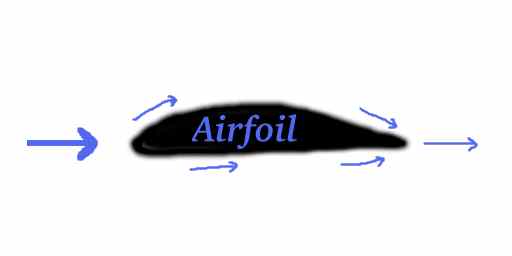
| MadSci Network: Earth Sciences |
Great question Annmarie!

Let's use the image above as a starting point. The sketch above is of a simple airfoil. Airfoils are the cross-sectional shape of airplane wings and of helicopter blades. The basic idea of an airfoil to generate lift, this is accomplished by the law of the conservation of mass. If you draw a box around the airfoil, the same about of air coming through that box at the leading edge of the airfoil from the left must leave the box on the right. However, the airfoil is in the way, so the air must go around it. The shape is part of the equation that gives us lift. The air must go faster across the top of the airfoil than across the bottom because it has a greater distance (yes there is also a smaller component of lift if the airfoil is angled to the air such that it just pushes the airfoil up). The faster velocity on the top causes the air pressure to be less than the pressure on the bottom, so the airfoil is lifted.
The key to your question is the air itself. The amount of lift must be enough to counteract the weight of the helicopter. The density of the air comes into the simple equation for lift.
The term rho is the density of the air, V is velocity, S is area of the wing or blade, and CL is the coefficient of lift that varies depending upon the airfoil used. The rho term is the important one here, the density of air decreases with elevation, not just a loss of oxygen, but a lack of air in general relative to sea level. With less density, you get less lift, and it is harder, or even impossible with current technology to fly a helicopter above a certain elevation. The brave Nepalese pilot that rescued the two climbers from above Base Camp in 1996 did everything that he could to reduce the weight of his helicopter so that the little lift that his helicopter was generating would be enough. Luckily it was.
I hope that answers your question. Good luck!
Steve
Try the links in the MadSci Library for more information on Earth Sciences.